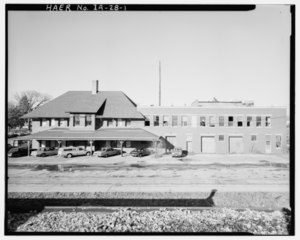
The City of Portland was a named passenger train on the Union Pacific Railroad between Chicago, Illinois, and Portland, Oregon. The first trip left Portland on June 6, 1935, using the streamlined M-10001 trainset. With only one set of equipment, the train left each terminal six times a month. A broken axle derailed the trip that left Chicago on July 23, 1935, and the repaired train resumed service with the trip leaving Portland on February 6, 1936. In May 1936 it started running five times a month instead of six, allowing more time in Chicago between trips.

The Chicago, Milwaukee, St. Paul and Pacific Railroad (CMStP&P), better known as the Milwaukee Road, was a Class I railroad that operated in the Midwest and Northwest of the United States from 1847 until 1986.

The City of Denver was a streamlined passenger train operated by the Union Pacific Railroad between Chicago, Illinois, and Denver, Colorado. It operated between 1936 and 1971. From 1936–1955 the Chicago and North Western Railway handled the train east of Omaha, Nebraska; the Chicago, Milwaukee, St. Paul and Pacific Railroad handled it thereafter. The train was the fastest long-distance train in the United States when it debuted in 1936, covering 1,048 miles (1,687 km) in 16 hours. For almost its entire career its principal competitor was the Chicago, Burlington and Quincy Railroad's Denver Zephyr. When Amtrak assumed operation of most intercity trains in the United States in 1971, it discontinued the City of Denver, preferring to use the Burlington's route between Chicago and Denver.
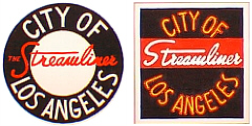
The City of Los Angeles was a streamlined passenger train between Chicago, Illinois, and Los Angeles, California via Omaha, Nebraska, and Ogden, Utah. Between Omaha and Los Angeles it ran on the Union Pacific Railroad; east of Omaha it ran on the Chicago and North Western Railway until October 1955 and on the Milwaukee Road thereafter. The train had number 103 westbound and number 104 eastbound.

The Chicago and North Western was a Class I railroad in the Midwestern United States. It was also known as the "North Western". The railroad operated more than 5,000 miles (8,000 km) of track at the turn of the 20th century, and over 12,000 miles (19,000 km) of track in seven states before retrenchment in the late 1970s. Until 1972, when the employees purchased the company, it was named the Chicago and North Western Railway.
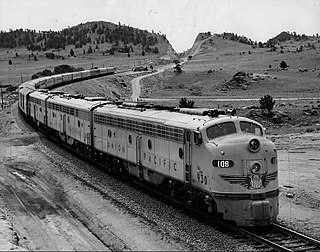
The Challengers were named passenger trains on the Union Pacific Railroad and the Chicago and North Western Railway. The economy service ran between Chicago, Illinois, and the West Coast of the United States. The trains had full Pullman service and coach seating and were an attempt to draw Depression-Era riders back to the rails. Food service was advertised as "three meals for under a dollar a day."

La Crosse station is an Amtrak intercity train station in La Crosse, Wisconsin, served by the daily Borealis and Empire Builder. The station was built in 1926–27 by the Chicago, Milwaukee, St. Paul, and Pacific Railroad, replacing an older station that burned in 1916. The station was listed on the National Register of Historic Places as the Chicago, Milwaukee and St. Paul Railway Depot and was renovated in 2001.
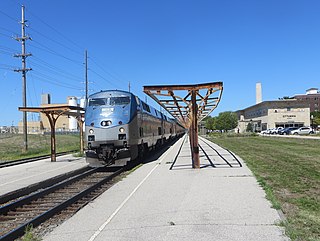
Ottumwa station is an Amtrak intercity train station in Ottumwa, Iowa, United States. The station was originally built by the Chicago, Burlington and Quincy Railroad, and has been listed as Burlington Depot by the National Register of Historic Places since November 26, 2008. It became a contributing property in the Historic Railroad District in 2011.
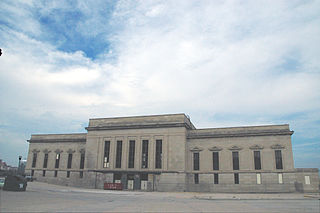
Railroads in Omaha, Nebraska, have been integral to the growth and development of the city, the state of Nebraska, the Western United States and the entire United States. The convergence of many railroad forces upon the city was by happenstance and synergy, as none of the Omaha leaders had a comprehensive strategy for bringing railroads to the city.

The Twin Cities Hiawatha, often just Hiawatha, was a named passenger train operated by the Chicago, Milwaukee, St. Paul and Pacific Railroad, and traveled from Chicago to the Twin Cities. The original train takes its name from the epic poem The Song of Hiawatha by Henry Wadsworth Longfellow. There are a number of Hiawatha-themed names within the city of Minneapolis, the terminus of the original train. The first Hiawatha ran in 1935; in 1939 the Milwaukee Road introduced a second daily trip between Chicago and Minneapolis. The two trains were known as the Morning Hiawatha and Afternoon Hiawatha, or sometimes the AM Twin Cities Hiawatha and PM Twin Cities Hiawatha. The Milwaukee Road discontinued the Afternoon Hiawatha in 1970 while the Morning Hiawatha continued running until the formation of Amtrak in 1971.

Chicago, Milwaukee, St. Paul and Pacific Depot – Delmar is a historic building located in Delmar, Iowa, United States. It is listed on the National Register of Historic Places.

The Burlington, Cedar Rapids and Northern Railway (BCR&N) was a railroad that operated in the United States from 1876 to 1903. It was formed to take over the operations of the bankrupt Burlington, Cedar Rapids and Minnesota Railway, which was, in turn, the result of merging several predecessor lines, the construction of which began in 1869. The corporate headquarters were in Cedar Rapids, Iowa, and it had operations in Iowa and in Minnesota. It was succeeded by the Chicago, Rock Island and Pacific Railway.
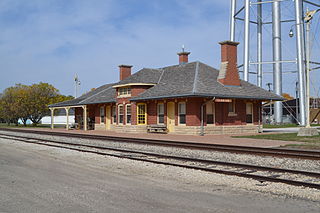
Burlington, Cedar Rapids and Northern Railroad Passenger Station, also known as Rock Island Railroad Depot and the Rock Island Depot Railroad Museum, is a historic building located in Clarion, Iowa, United States. The station was built in 1898 by contractor A. H. Connor & Company of Cedar Rapids, Iowa for the Burlington, Cedar Rapids and Northern Railroad (BCR&N). Clarion also had a Chicago Great Western Railway depot, no longer extant. At one time there were 14 trains that served the city. In 1903 the Chicago, Rock Island and Pacific Railway acquired the BCR&N, and this depot served that railroad. The single story, Romanesque Revival, brick structure measures 26 by 88.5 feet. It was added to the National Register of Historic Places in 1988.

The Kate Shelley 400 was a short-lived streamlined passenger train operated by the Chicago and North Western Railway between Chicago, Illinois and Iowa. The train drew its name from the CNW's popular Twin Cities 400, so-named for making the 400-mile (644 km) run from Chicago to Minneapolis, Minnesota in 400 minutes, and Kate Shelley, a young woman who in 1881 risked her life to save a passenger train from a washed-out bridge. The C&NW introduced the Kate Shelley to fill the void left by the Union Pacific Railroad's famed "City" streamliners, which had moved from the CNW's route to that of the Milwaukee Road. The Kate Shelley made its first run in October 1955. Initially it operated to Boone, Iowa, but this was cut back in 1956 to Cedar Rapids, Iowa, and then again in 1957 to Clinton, Iowa, just across the Mississippi River. The CNW dropped the name altogether on July 23, 1963, though the unnamed trains #1 and #2 continued running until the formation of Amtrak in 1971, when they were discontinued.

The Burlington, Cedar Rapids & Northern Freight House, also known as the Rock Island Freight House, is a historic building located in Burlington, Iowa, United States. It was listed on the National Register of Historic Places in 1983.
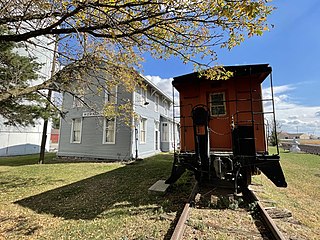
The Chicago, Milwaukee, St. Paul & Pacific Combination Depot-Hornick, also known as the Hornick Depot, is a historic building located in Hornick, Iowa, United States. The town was patted by the Chicago, Milwaukee, St. Paul & Pacific Railroad's land company when the railroad created a branch line from Manilla, Iowa to Sioux City. Completed in 1887, the railroad built this two-story frame structure to serve as its passenger and freight depot. It is one of six such depots that remain in Iowa, and the best preserved. These buildings were built from a standard design used by the railroad. The two-story stations included living quarters for the station manager because the towns had yet to develop when the depot was built. This was an island depot, with freight loaded on the north side and passengers boarded on the south. Decorative elements on this depot include lathe-turned wooden finials, angled wooden brackets, and bracketed door and window hoods. Passenger service ended in the 1950s, and grain was loaded here until 1980 when the Milwaukee Road abandoned the Sioux City branch line. The building was listed on the National Register of Historic Places in 1990. It has been converted into a local history museum.

The Milwaukee Road Depot in Madison, Wisconsin is a former railroad depot. It was built in 1903 and operated by the Chicago, Milwaukee, St. Paul and Pacific Railroad. It served numerous passenger trains, including the Sioux and Varsity, and was located next to a major yard, turntable, and roundhouse. The station was one of two Milwaukee Road stations in Madison, and was also known as West Madison station or West Madison Depot to avoid confusion with Franklin Street station on the east side of Madison. All Milwaukee Road passenger service in Madison was consolidated to this station with the closing of Franklin Street in 1952. The Milwaukee Road's service from Chicago to Minneapolis-St. Paul traveled through Milwaukee and central Wisconsin, bypassing Madison to the north. The railroad's competitor, the Chicago and North Western Railroad, offered direct service northwest to Minneapolis.

The Cedar Rapids Union Station served different railroads' passenger operations for six decades. The structure at 4th Street and 4th Avenue SE, Cedar Rapids, was opened with fanfare in 1897 with a gala for Cedar Rapids' charities. The station was 600 feet long with gargoyles. The interior of the main building was 40 by 400 feet and 27 feet high.

Madison station is a former railroad station in Madison, Wisconsin. The station served passenger and freight trains of the Chicago and North Western Railway (C&NW). Passenger service ended in 1965 and the passenger station and freight depot was bought by Madison Gas and Electric (MGE) and has been renovated to serve as offices. The station and freight depot are listed as contributing properties on the National Register of Historic Places East Wilson Street Historic District. The Chicago, Milwaukee, St. Paul and Pacific Railroad had tracks paralleling the C&NW and also had a nearby passenger station that outlasted the C&NW station as an active station by several years.

DeKalb station is a former railway station in Downtown DeKalb, Illinois. It served passenger trains of the Chicago and North Western Railway (C&NW) along its main line between Chicago and Omaha. The station was designed by Charles Sumner Frost and Alfred Hoyt Granger in 1891 and closed for passenger service in 1971. The building still stands and is used by the Union Pacific Railroad for offices.
